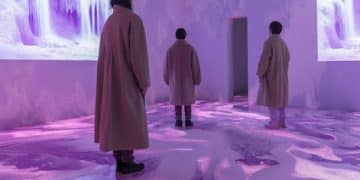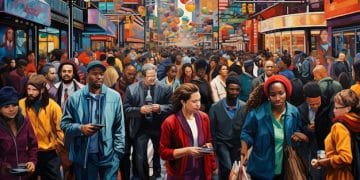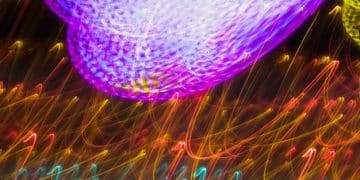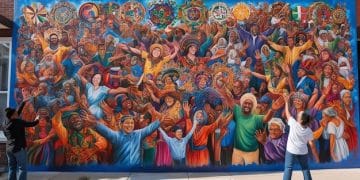Future of Public Art in US: 5 Innovative Projects
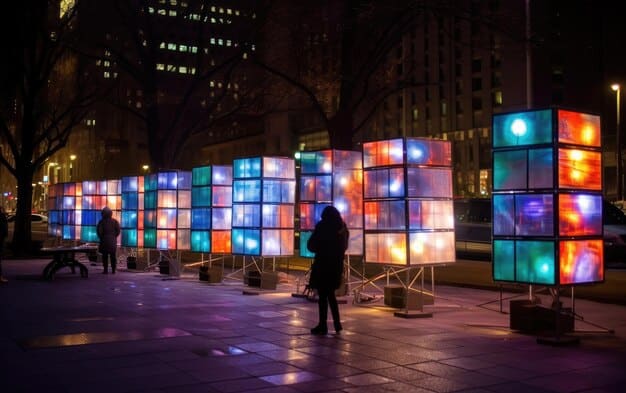
Advertisements
The future of public art in the US is dynamic and transformative, moving beyond traditional forms to embrace technology, community engagement, and environmental consciousness, as evidenced by pioneering projects nationwide.
What is the Future of Public Art in the US? Examining 5 Innovative Projects Nationwide reveals a landscape undergoing profound evolution. Public art, once primarily monumental and static, is now reshaping urban environments and social narratives. This evolution prompts us to consider how these creative interventions are not merely decorative, but integral to communal identity and urban development.
The Evolving Canvas: Shifts in Public Art Paradigms
Public art in the United States is continuously redefining its boundaries and purpose. Historically, it often served to commemorate historical figures or significant events, frequently through statues and murals. While these forms still hold value, a marked shift towards more temporary, interactive, and socially engaged practices is unmistakably underway. This evolution reflects broader societal changes, including increased digital literacy, a greater emphasis on community participation, and a growing awareness of environmental issues.
One primary shift is the move from static installations to dynamic, ephemeral experiences. Artists are increasingly utilizing technology, light, and performance to create art that changes over time, responds to its environment, or involves direct interaction from the public. This approach challenges traditional notions of permanence and instead prioritizes engagement and immediate impact. Such works often encourage passersby to become active participants rather than passive observers, fostering a deeper connection to the art and its message.
Technology as a Medium and Message
The integration of technology has profoundly altered how public art is conceived and experienced. Digital projections, augmented reality (AR), and interactive sensors are becoming commonplace tools, enabling artists to create immersive worlds and responsive installations. This technological embrace allows for art that is not only visually stunning but also intellectually stimulating, prompting viewers to consider their relationship with the digital realm and the physical space it inhabits.
- Digital Projections: Transforming building facades into canvases for narratives and abstract light shows.
- Augmented Reality: Layering virtual art onto real-world environments, accessible via smartphones.
- Interactive Sensors: Artworks that respond to human presence, movement, or even environmental data like wind and sound.
Community Engagement and Social Practice
Beyond aesthetics, public art is increasingly viewed as a tool for community building and social commentary. Artists are collaborating directly with local residents, incorporating their stories, ideas, and histories into the artwork. This participatory process ensures the art is deeply resonant with the community it serves and can facilitate dialogues on important social issues. The emphasis is on creation with, rather than for, the public.
Moreover, public art is being utilized as a catalyst for urban renewal, transforming neglected spaces into vibrant cultural hubs. By activating underused areas, these projects can foster a sense of pride and ownership among residents, attracting visitors and stimulating local economies. The art becomes a destination, contributing to the cultural fabric and economic vitality of a neighborhood.
Ultimately, the evolving canvas of public art is characterized by its adaptability, its embrace of interdisciplinary approaches, and its commitment to fostering meaningful connections. It is a field that remains in flux, driven by artists who constantly push boundaries and communities seeking new ways to express their collective identity.
Project Spotlight 1: The High Line, New York City
The High Line in New York City stands as a quintessential example of how public art can be seamlessly integrated into urban infrastructure, transforming a derelict elevated railway into a vibrant public park and art exhibition space. This project is not merely about placing sculptures; it’s about curating experiences within a unique urban landscape, demonstrating a profound understanding of how art, nature, and urban spaces can coalesce.
Originally opened in phases starting in 2009, The High Line annually features a rotating series of site-specific commissions, performances, and temporary installations. These artworks are carefully selected to respond to the park’s unusual context – elevated above city streets, amidst a backdrop of skyscrapers and historic buildings. The curators often seek out pieces that engage with the themes of nature, urbanism, and the history of the High Line itself, which once played a vital role in the city’s industrial past.
Responsive and Ephemeral Installations
One of the key aspects of The High Line’s art program is its embrace of temporary and responsive installations. Unlike permanent monuments, these pieces offer fresh perspectives with each visit, encouraging repeat engagement. This dynamic approach ensures that the park remains a living canvas, constantly evolving and surprising its visitors. The temporary nature also allows for experimentation, giving artists the freedom to explore bold new ideas without the pressure of creating a permanent fixture.
- Seasonal Rotations: Artworks are changed with the seasons, reflecting the natural cycles visible from the elevated park.
- Performance Art: Live performances activate various sections of the High Line, turning pedestrian paths into stages.
- Site-Specific Design: Artists often create pieces explicitly for a particular niche or viewpoint along the park.
Blurring the Lines Between Art and Environment
The High Line exemplifies a future where public art deeply integrates with its natural and built environment. The art installations often use materials and forms that echo the park’s horticultural design or the industrial aesthetics of its surroundings. This intentional blurring of lines encourages visitors to see the entire park as a curated artistic experience, where every bench, plant, and vista contributes to the overall aesthetic narrative. It’s an immersive experience rather than a collection of isolated artworks.
Furthermore, The High Line serves as a model for urban regeneration through creative placemaking. Its success has inspired similar projects globally, demonstrating the transformative power of repurposing forgotten infrastructure for public enjoyment and artistic expression. It champions a future where public art is not an afterthought but a foundational element of innovative urban planning. The lessons learned from this project are invaluable for cities looking to harness creativity for community benefit and sustainable development.
Project Spotlight 2: Meow Wolf, Santa Fe, New Mexico
Meow Wolf in Santa Fe, New Mexico, is not just an art exhibit; it’s an immersive, narrative-driven experience that challenges traditional notions of public art and gallery spaces. This artist collective’s groundbreaking approach has created a unique form of interactive, accessible art that invites visitors to explore fantastical worlds and uncover hidden stories. Their flagship exhibit, “House of Eternal Return,” is a prime example of how art can become a living, breathing environment.
Born from a collective of artists who initially repurposed found materials into large-scale installations, Meow Wolf has evolved into a nationally recognized entity, focusing on maximalist, labyrinthine installations that appeal to all ages. Their work is characterized by vibrant colors, surreal environments, and a tactile quality that encourages touch and exploration. This departure from the “look but don’t touch” museum etiquette is central to their philosophy, fostering a more direct and personal engagement with the artwork.
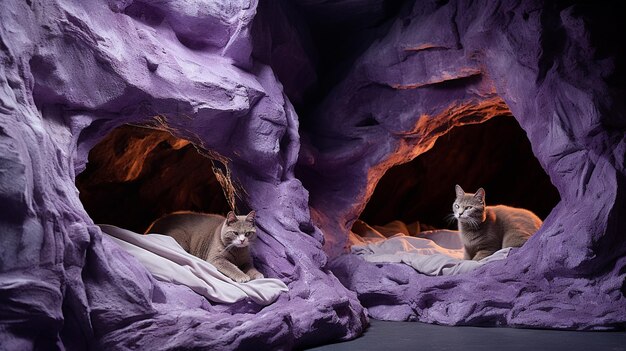
Immersive Storytelling and Participatory Art
At the core of Meow Wolf’s appeal is its commitment to immersive storytelling. Each exhibit, whether in Santa Fe, Denver, or Las Vegas, presents a sprawling narrative that visitors can piece together by exploring different rooms, objects, and hidden passages. This narrative framework elevates the experience beyond mere visual spectacle, turning it into an adventure. Visitors become detectives, uncovering clues and constructing their own understanding of the world presented.
- Narrative Layers: Multiple storylines interwoven throughout the exhibit, discoverable through exploration.
- Interactive Elements: Every object potentially holds a clue or triggers a response, encouraging hands-on engagement.
- Non-Linear Exploration: No prescribed path, allowing visitors to forge their own journey through the art.
Redefining Art Accessibility and Engagement
Meow Wolf significantly redefines who public art is for and how it can be experienced. By moving away from the often intimidating atmosphere of traditional galleries, they have cultivated an environment that is welcoming and exciting for a broad audience, including families and those new to art. This accessibility is key to expanding the reach and impact of contemporary art, proving that complex ideas can be presented in an engaging, playful format.
Their innovative business model, which supports artists directly and provides a platform for large-scale creative projects, also points to a future where artists have more autonomy and direct connection with their audiences. Meow Wolf exemplifies how art can be both a cultural phenomenon and a sustainable economic engine, fostering creativity and community development on a grand scale. It represents a bold step into a future where public art is synonymous with adventure and collective discovery.
Project Spotlight 3: The Ocean Cleanup’s Interceptor, Various Locations
While not “art” in the traditional sense, The Ocean Cleanup’s Interceptor project symbolizes a vital intersection between innovative technology, environmental imperative, and public awareness, which increasingly defines a segment of future public installations. This project, which aims to clean plastic from rivers before it reaches the oceans, acts as a functional sculpture, a statement of intent, and a visible commitment to addressing global environmental challenges. Its presence in waterways worldwide serves as a constant, tangible reminder of humanity’s impact on the planet.
The Interceptor itself is a sophisticated solar-powered system designed to autonomously extract plastic waste from rivers. Visually, it is an imposing yet elegant structure, often adorned with informational displays about its mission. Its deployment transforms a river, typically seen as a conduit for waste, into a proactive site of environmental restoration. This innovative blend of engineering and environmentalism pushes the boundaries of what public installations can achieve, moving beyond purely aesthetic or commemorative functions to address pressing global issues directly.
Visible Impact and Educational Outreach
One of the most compelling aspects of The Interceptor is its highly visible impact. As the device collects tonnes of plastic, its presence encourages dialogue and raises awareness about plastic pollution. It serves as an active, educational landmark, inviting communities to understand the scale of the problem and the potential for technological solutions. This direct engagement with an environmental issue elevates the Interceptor beyond a mere piece of equipment to a symbol of hope and progress.
- Real-Time Data: Some Interceptors are equipped to display real-time data on collected plastic, sharing progress with the public.
- Community Engagement: Partnerships with local governments and environmental groups promote river health and clean-up efforts.
- Inspiring Action: The visible efforts encourage individuals and industries to reduce their plastic consumption.
Functional Aesthetics and Environmental Art
The Interceptor embodies a future where functional design is inherently artistic, and environmental activism manifests in tangible, impactful installations. Its sleek design and efficient operation make it an object of both utility and aesthetic appreciation. This approach aligns with a growing movement in public art that prioritizes ecological responsibility and sustainability, often utilizing recycled materials or creating installations that draw attention to environmental degradation.
While not commissioned by an art institution, the Interceptor’s conceptual depth and visual presence mark it as a powerful public artwork of the 21st century. It challenges definitions, proving that critical public art can be less about traditional forms and more about meaningful intervention and measurable change. Its integration of advanced technology with a clear environmental mission offers a compelling vision for future public installations that serve a higher, collective purpose.
Project Spotlight 4: Murals of La Jolla, California
The Murals of La Jolla project in California represents a different but equally compelling facet of the future of public art: a curated, rotating outdoor gallery that transforms the urban fabric through the power of large-scale contemporary painting. Unlike static historical monuments, this project emphasizes dynamism and artistic innovation on building facades, integrating high-caliber art directly into everyday life in a sophisticated coastal community. It’s a testament to how temporary, high-quality interventions can continuously refresh a public space.
Initiated in 2010 by the Athenaeum Music & Arts Library, the project commissions artists, oftentimes internationally renowned, to paint original murals on private buildings throughout La Jolla. This model circumvents many traditional bureaucratic hurdles, allowing for a more agile and experimental approach to public art. The rotating nature of the murals ensures that the visual landscape of the town remains fresh and engaging, encouraging repeat visits and fostering a sense of artistic discovery among residents and tourists alike.
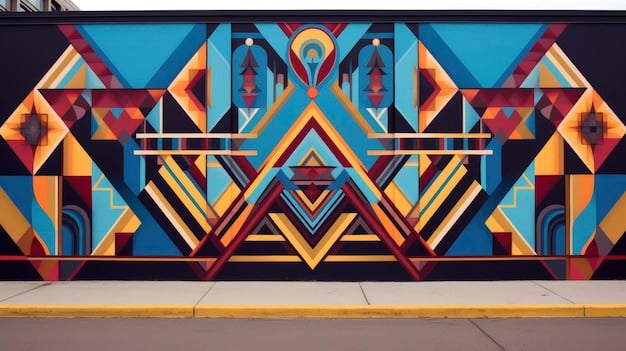
Curatorial Excellence and Artistic Freedom
A hallmark of the Murals of La Jolla is its commitment to curatorial excellence. The selection process ensures that each mural is not only visually striking but also represents significant contemporary artistic vision. This dedication elevates street art to a fine art form, respected within both local and national art communities. Artists are given considerable freedom, leading to a diverse array of styles and subject matters that reflect the breadth of contemporary painting.
- High-Profile Artists: Featuring works by established and emerging artists from around the world.
- Rotating Collection: Murals are repainted every few years, maintaining freshness and allowing new artistic voices.
- Unconventional Canvases: Utilizing varied building surfaces, from concrete walls to irregular facades, as unique canvases.
Integrating Art into Daily Life
The project successfully integrates major artistic statements into the daily routine of La Jolla residents. The murals become part of the everyday commute, a backdrop to shopping and dining, and a constant source of visual intellectual stimulation. This pervasive presence of art fosters a culturally enriched environment, making art accessible outside of traditional gallery settings and encouraging spontaneous encounters with creativity. It democratizes art appreciation by literally putting it on the street.
The Murals of La Jolla demonstrate a viable and impactful future for public art where private initiatives and thoughtful curation can create a dynamic, open-air museum. It showcases how temporary art can have a lasting cultural footprint, proving that permanence isn’t always a prerequisite for profound artistic impact. This model offers valuable insights for other communities seeking to invigorate their public spaces with high-quality, evolving artistic expressions.
Project Spotlight 5: The Museum of Ice Cream, Various US Cities
The Museum of Ice Cream (MOIC), with locations in multiple US cities including New York and Los Angeles, represents a unique category in the evolution of public-facing art: the “experiential museum” or “Instagrammable art installation.” While often criticized for prioritizing aesthetics over conceptual depth, MOIC undeniably exemplifies a future where public art is designed for maximum sensory engagement, social media virality, and a broad, entertainment-seeking audience. It blurs the lines between art, entertainment, and commercial venture.
MOIC is not a traditional museum; it’s a series of highly stylized, interactive rooms, each themed around ice cream and its cultural associations. From a sprinkle pool to giant melting popsicles, every element is meticulously designed to be visually arresting and photo-ready. This approach acknowledges the pervasive influence of social media on how people experience and share cultural events. It taps into a desire for shareable moments, transforming visitors into active participants in the art’s dissemination.
Designing for Engagement and Shareability
The core innovation of MOIC lies in its deliberate design for engagement and social media sharing. Each room is meticulously crafted to be a backdrop for photos and videos, encouraging visitors to create their own content within the space. This user-generated content acts as powerful, organic marketing, extending the reach of the installation far beyond its physical location. It’s a commercial enterprise that has successfully leveraged the participatory nature of modern media consumption.
- Themed Rooms: Each space offers a distinct, highly visual experience focused on a specific ice cream concept.
- Interactive Elements: Slides, swings, and tactile installations encourage playful physical engagement.
- Photo Opportunities: Every corner is designed to be a perfect backdrop for social media content.
Public Art as Immersive Entertainment
MOIC signifies a shift towards public art becoming a form of immersive entertainment, accessible and appealing to a mass audience who might not typically visit traditional art institutions. This trend suggests a future where public artworks are not just objects to be admired, but environments to be experienced, played in, and shared. It speaks to a younger, more digitally native generation that seeks multisensory, fun, and personally relevant cultural experiences.
While purists might debate its artistic merit, MOIC’s commercial success and widespread popularity reveal a significant evolution in public interaction with creative spaces. It demonstrates how public art can adapt to contemporary desires for novelty, interactivity, and personal connection in an increasingly digital world. This project, and others like it, indicate a future where art and entertainment continue to converge, creating new forms of public engagement that prioritize experience above all else. This movement acknowledges that for art to truly resonate broadly, it must sometimes embrace the playful and the popular.
| Key Aspect | Brief Description |
|---|---|
| 🎨 Interactive & Immersive | Public art moving towards engaging viewer participation and multi-sensory experiences. |
| 💡 Tech Integration | Utilizing digital projections, AR, and sensors for dynamic, evolving installations. |
| 🌍 Societal Relevance | Addressing environmental issues, promoting community dialogue, and aiding urban renewal. |
| 🔄 Ephemeral & Adaptable | A growing trend towards temporary, rotating art that keeps urban landscapes fresh. |
Frequently Asked Questions about Public Art
▼
In the contemporary US context, public art extends beyond traditional statues to include any art accessible to the public, often outside conventional exhibition spaces. It embraces diverse mediums like murals, digital projections, interactive installations, and even environmental interventions. What defines it most is its engagement with a broad audience and its ability to reflect or influence public discourse and the character of a specific place.
▼
Technology profoundly impacts public art by enabling dynamic, interactive, and ephemeral experiences. Digital projections can transform surfaces, augmented reality layers virtual art onto real spaces, and sensors allow artworks to respond to their environment or audience. This integration creates immersive experiences, fosters direct engagement, and allows for art that is constantly evolving, pushing the boundaries of traditional artistic forms.
▼
Community engagement is a pivotal role in modern public art. It ensures that artworks are not just imposed on a space but are deeply resonant with the local populace. Through participatory workshops, interviews, and collaborations, artists can incorporate community stories and ideas, fostering a sense of ownership and relevance. This engagement transforms art into a tool for social cohesion, dialogue, and even urban regeneration, making the art truly by and for the public.
▼
Yes, temporary public art installations are indeed becoming more prevalent. They offer immense flexibility, allowing artists to experiment with bold ideas without the commitment of permanence. For cities, temporary art keeps the urban landscape fresh, encourages repeat visits, and can activate spaces more quickly than permanent installations. They also reduce long-term maintenance costs and provide opportunities to feature a wider range of artists and artistic styles, keeping public art dynamic and stimulating.
▼
Public art contributes significantly to urban development and placemaking by enhancing the aesthetic appeal of a city, fostering local identity, and attracting tourism. It can transform neglected spaces into vibrant cultural destinations, increase foot traffic, and stimulate local economies. By creating unique visual landmarks and experiences, public art helps define a neighborhood’s character, strengthens community pride, and encourages social interaction, making places more livable and memorable.
Conclusion
The future of public art in the US is undeniably vibrant, multifaceted, and increasingly integrated into the very fabric of our communities. From the elevated green spaces of The High Line to the immersive narratives of Meow Wolf, the innovative solutions for environmental challenges like The Ocean Cleanup’s Interceptor, the ever-changing canvases of Murals of La Jolla, and the playful experiential realms of the Museum of Ice Cream, these projects highlight a profound evolution. Public art is moving beyond mere ornamentation to become a dynamic force for community engagement, technological innovation, environmental consciousness, and captivating entertainment. It reflects a growing recognition that art, when placed in the public sphere, holds immense power to shape our collective identity, foster dialogue, and inspire new ways of seeing and interacting with our world. As artists continue to push boundaries and communities embrace creative placemaking, the landscape of public art will continue to evolve, offering endless possibilities for enrichment and transformation across the nation.
